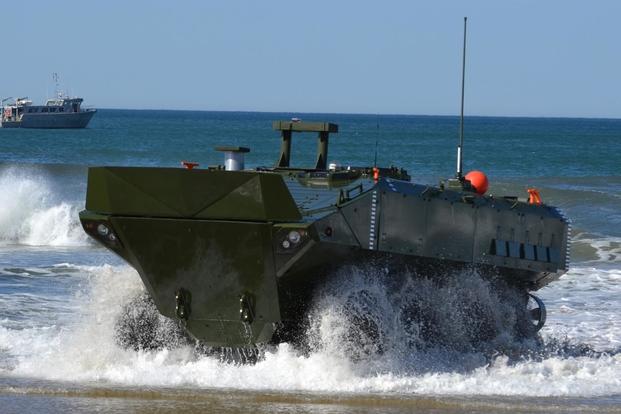The Marine Corps' next fight is not going to be like the last one.
That's why it's imperative the service pushes much-needed upgraded equipment out to warfighters, Brig. Gen. A. J. Pasagian, the head of Marine Corps Systems Command said last week.
Three of the men that helped do that were the first-ever recipients of awards in acquisition excellence, presented at the Marine Corps Association and Foundation awards dinner outside Washington, D.C., on Thursday, August 23. Master Sgt. Zackary Hefty, Capt. Anthony Molnar and Nicholas Pierce were selected to receive the prestigious awards for excellence in acquisition.
Hefty was instrumental in developmental testing for the Amphibious Combat Vehicle 1.1, which will help launch Marines from ships to shore. Molnar is responsible for helping redesign a new, safer version of the MK-154 Launcher Mine-Clearance System. And Pierce got next-generation body armor out to Marine units a year ahead of schedule.
Their efforts are in line with what Defense Secretary Jim Mattis pushes from the Pentagon's highest office, said James Geurts, assistant secretary of the Navy for research development and acquisition.
"If we're doing anything that isn't going to help us compete and win, then we need to stop," Geurts said.
Troops sometimes grumble that gear doesn't reach them quickly enough in the operating forces. But the three who won these awards are examples of the work that goes into getting the right gear into the field at the right time, Pasagian told Military.com.
"Each of them has a very direct and close relationship with what I call operational necessity," he said. "They're well-tuned into the operational need of what they're working on. ... That's the common thread that binds them all together."
Hefty, an amphibious assault vehicle crew chief, is credited with showing exceptional leadership as test director of the Amphibious Vehicle Test Branch. He personally trained eight sergeants on the proper procedures for executing developmental tests sections and was key in the ACV 1.1's first-ever embarkation and debarkation aboard Navy ships.
"The successful execution of this acquisition program helped to reduce deployment time and cost to the government," Hefty's award citation states. He credits all of that to his team, though.
"We accomplished this together," he said.
Molnar, a prior-enlisted Marine and combat engineer officer, helped get a product back into the hands of AAV crews that allows them to clear mines as they hit the beach -- an incredibly important tool as the area between a Navy ship and the shore grows more contested.
"He completed three milestone decision briefs and key acquisition events that resulted in the redesign of the MK154 Mod 1 system with less than $1.2 million in programmed funding," his award citation states.
Molnar continues to innovate, co-designing a mobile recycling facility that can turn food-safe plastics into 3-D printing materials. By turning deployed Marines' waste into plastic, the process will reduce the logistics supply chain footprint.
As the commandant pushes for leathernecks at all ranks to be more innovative, Molnar said they can't be afraid of being an outsider.
"You have to be willing to be an outcast and buck the system, and in the military, that's kind of frowned upon," he said. "But if you push the envelope for change ... you can lay your head on the pillow at night knowing that you're right, and that's all that matters."
--Gina Harkins can be reached at gina.harkins@military.com. Follow her on Twitter at @ginaaharkins.










